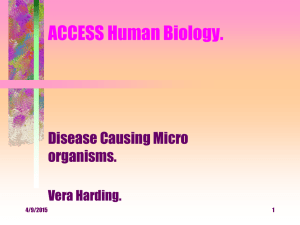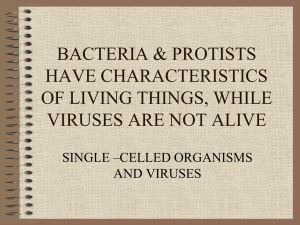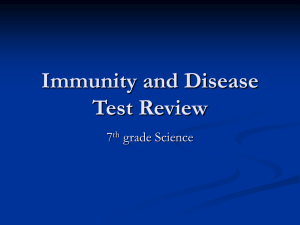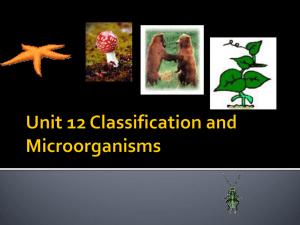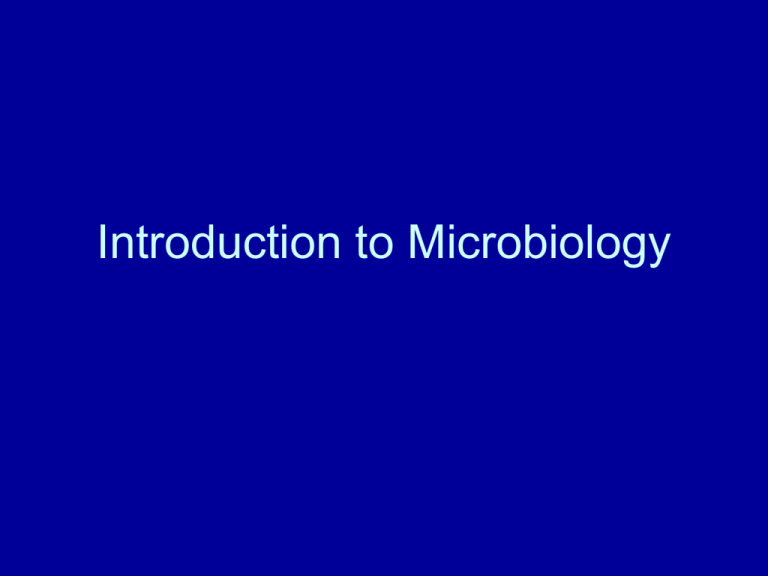
Introduction to Microbiology
A Brief History of Microbiology
• Development of microscopy:
• 1590: Hans (漢司) and Zacharias Janssen (詹森)
(Dutch lens grinders) mounted two lenses in a
tube to produce the first compound microscope.
• 1660: Robert Hooke (虎克) (1635-1703)
published "Micrographia", containing drawings
and detailed observations of biological materials
made with the best compound microscope and
illumination system of the time.
• 1676: Anton van Leeuwenhoek (劉文虎克)
(1632-1723, Holland) was the first person to
observe microorganisms.
• 1883: Carl Zeiss (蔡斯) (German maker of
optical instruments) and Ernst Abbe (艾比)
(German physicist, optometrist, entrepreneur,
and social reformer ) pioneered developments in
microscopy (such as oil immersion lenses (油浸
鏡)and apochromatic (複消色差) lenses which
reduce chromatic aberration[色差]) which persist
until the present day.
• 1931: Ernst Ruska (盧思卡) (German
physicist who won the Nobel Prize in
Physics in 1986) constructed the first
electron microscope.#
Spontaneous generation
controversy
• 1688: Francesco Redi (瑞迪) (1626-1678) was
an Italian physician who refuted the idea of
spontaneous generation by showing that rotting
meat carefully kept from flies will not
spontaneously produce maggots.
• 1836: Theodor Schwann (許旺) (1810-1882)
helped develop the cell theory of living
organisms, namely that that all living organisms
are composed of one or more cells and that the
cell is the basic functional unit of living
organisms.
•
•
•
•
1861: Louis Pasteur‘s (巴斯德) (18221895) famous experiments with swannecked flasks finally proved that
microorganisms do not arise by
spontaneous generation.
This eventually led to:
Development of sterilization (消毒)
Development of aseptic technique (無菌)
#
Proof that microbes cause disease
• 1546: Hieronymus Fracastorius (法拉科斯
特) (Girolamo Fracastoro) (Italian
physician, poet, and scholar in
mathematics, geography and astronomy)
wrote "On Contagion" (接觸傳染) ("De
contagione et contagiosis morbis et
curatione"), the first known discussion of
the phenomenon of contagious infection.
• 1835 Agostino Bassi de Lodi (羅迪) (Italian
entomologist) showed that a disease
affecting silkworms was caused by a
fungus - the first microorganism to be
recognized as a contagious agent of
animal disease.
• 1847: Ignaz Semmelweiss (森梅威斯)
(1818-1865), a Hungarian physician who
decided that doctors in Vienna hospitals
were spreading childbed fever while
delivering babies. He started forcing
doctors under his supervision to wash their
hands before touching patients.
• 1857: Louis Pasteur (巴斯德) proposed the
“germ theory” of disease (疾病的病菌學說).
•
1867: Joseph Lister (李斯特) (1827-1912)
(British surgeon) introduced antiseptics
(無菌) in surgery. By spraying carbolic
acid (石炭酸, phenol,使細菌細胞的原生質
蛋白發生凝固或變性而殺菌) on surgical
instruments, wounds and dressings, he
reduced surgical mortality due to
bacterial infection considerably.
• 1876: Robert Koch (寇赫) (1843-1910).
German bacteriologist was the first to
cultivate anthrax (炭疽) bacteria outside
the body using blood serum at body
temperature. Building on pasteur‘s “germ
theory”, he subsequently published
“Koch’s postulates” (寇赫假說) (1884),
the critical test for the involvement of a
microorganism in a disease:
炭疽病
•形容感染者皮膚上焦黑的損傷病變
•一種人畜共通病 ,炭疽可透過消化道、呼
吸道、皮膚接觸等途徑進入人體,人感染
後,則發生皮膚膿疱、咳嗽、吐痰、呼吸
困難、脾臟腫脹等症狀。
•肺(呼吸)和腸胃炭疽病不治療致死率達
100%。
•皮膚炭疽病不加以治療卻仍有20%的致死率,
治療後幾乎不會有危險。
• The agent must be present in every case
of the disease.
• The agent must be isolated and cultured in
vitro.
• The disease must be reproduced when a
pure culture of the agent is inoculated into
a susceptible host.
• The agent must be recoverable from the
experimentally-infected host.
• This eventually led to:
• Development of pure culture (純種培養)
techniques
• Stains (染色), agar (洋菜), culture media
(培養基), petri dishes (培養皿) #
Microbial Pathogenesis
•
•
•
•
What does a pathogen have to do?
Infect (infest) a host
Reproduce (replicate) itself
Ensure that its progeny are transmitted to
another host
Mechanisms of Transmission(傳染)
• Aerosols (氣溶膠)- inhalation of droplets, e.g.
Rhinoviruses (鼻病毒), the 'Common Cold Virus'
or Adenoviruses (腺病毒).
• Faecal-Oral (糞便)- e.g. Astroviruses (星狀病毒),
Caliciviruses (嵌杯樣病毒); these viruses cause
acute gastroenteritis (胃腸炎).
• Vector-borne ( 媒介)- e.g. in Arthropods such
as mosquitos, ticks (壁蝨), fleas: Arboviruses (蟲
媒病毒).
• Close personal contact (親密接觸)- especially
exchange of bodily fluids: Sex; Blood, e.g.
Herpesviruses (皰疹病毒). #
• Generally today, the all-encompassing
group of “microbes” are divided into
viruses (病毒), bacteria (細菌), fungi (真菌),
and protozoans (原生動物).
Viruses
• Viruses are the simplest organisms we are
aware of. They are essentially nucleic acid
(核酸) (viruses can have genomes
consisting of either DNA or RNA) wrapped
in a protein coat.
• On their own, viruses are incapable of any
metabolism, including replication. However,
viruses contain proteins on their surface
which facilitate binding to and entry into
cells of every type imaginable, from
bacteria to human cells.
• A single cell may produce anywhere from
10,000 to 50,000 new viruses in as little as
48 hours’ time.
• Diseases caused by viruses include
influenza, the common cold, herpes (皰疹),
Ebola, and AIDS.
埃博拉(Ebola)
•一群屬於纖維病毒科埃博拉病毒屬下數種
病毒的通用術語,可導致埃博拉病毒出血
熱此病可致人於死,包含數種不同程度的
症狀,包括噁心、嘔吐、腹瀉、膚色改變、
全身痠痛、體內出血、體外出血、發燒等,
具有50%至90%的致死率,致死原因主要為
中風、心肌梗塞、低血容量休克或多發性
器官衰竭。
•此病毒以非洲剛果民主共和國的埃博拉河命名
(該國舊稱薩伊)
•埃博拉是人畜共通病毒,通常藉由體液、黏膜、
皮膚等接觸造成感染。
•至今仍沒有辨認出任何有能力在爆發時存活的動
物宿主,目前認為果蝠是病毒可能的原宿主
•因為埃博拉的致命力,加上目前尚未有任何疫苗
被證實有效,埃博拉被列為生物安全第四級病毒
Flu and Common cold
• The common cold eventually fizzles (消退),
but the flu may be deadly.
• The flu is caused by the influenza virus, a
respiratory virus and is preventable with
vaccination (疫苗).
• The common cold is caused by the
adenovirus or coronavirus (冠狀病毒) and
there are many, many subsets with a lot of
variability.
• Flu causes epidemics and pandemics (covers a
much wider geographical area, often worldwide.)
with the potential for mortality, whereas the
common cold is a nuisance (騷擾行為) for us.
• Both colds and flu usually last the same seven to
10 days, but flu can go three to four weeks; the
flu virus may not still be there, but you have
symptoms long after it's left.
Bacteria
• Bacteria are single-celled organisms which
populate almost every niche on earth, from
the hottest springs and chilliest waters to
many spaces on and within the human
body. As a group they are extremely
diverse in size, shape, motility, nutrient
requirements and pathogenicity (ability to
cause disease), but share the common
trait of lacking a true nucleus (and hence
are referred to as “prokaryotic”,原核生物).
• Though most of the earliest bacteria
discovered were pathogens (diseasecausing organisms), the vast majority of
bacteria on earth are harmless, or even
helpful, to humans. Many animals rely on
gut bacteria to provide nutrients from food,
which we are unable to synthesize
ourselves (for example, E. coli (大腸菌) in
the gut produce Vitamin K).
• Additionally, commensal (共生) (nonpathogenic) bacteria fill niches in our body
and use resources that would otherwise
be available to other pathogenic
microorganisms.
•
Diseases caused by bacteria include
tuberculosis (結核病) (Mycobacterium
tuberculosis), “Black Plague,” (黑死病)
(Yersinia pestis), strep throat (鏈球菌性
喉炎) (Streptococcus pyogenes), and
syphilis (梅毒) (Treponema pallidum).
Protozoans
• Protozoans are single-celled, eukaryotic
(真核生物) organisms belonging to the
kingdom Protista. This means that, like
human cells, they have a true nucleus.
Most protozoa are motile as well, and are
often fairly large for a single-celled
organism (generally 1-100 microns in size,
although some can be up to 1 millimeter in
length).
• Diseases caused by protozoa include:
malaria (瘧疾) (Plasmodium falciparum),
sleeping sickness (Trypanosoma cruzi) (非
洲錐蟲病), amoebic dysentery
(Entamoeba histolytica) (阿米巴痢疾).
Fungi
• Fungi are also eukaryotic, and include
organisms such as molds and yeasts.
Approximately 100 fungal species (out of
~100,000 known) are pathogenic for man.
Yeasts are superficially similar to bacteria,
in that they are unicellular and generally
divide by simple binary fission (one cell
divides into two).
• Molds, on the other hand, generally have
complex life cycles during which they pass
through both an asexual and a sexual
stage. They exist as multicellular
organisms during much of this period, and
at this point, are far from being “micro”
organisms. Nevertheless, because it is
often their (microscopic) spores (孢子)
which are responsible for diseases, they
remain classed as general “microbes.”
• Diseases caused by fungi include thrush
(黴菌性口炎,鵝口瘡) and yeast infections
of candida (假絲酵母) and thrush in babies,
and ringworm (金錢癬)/athlete’s foot
(various species).###
immune system
• many of the symptoms of an infectious
disease are due to responses of the
immune system. Fever, for example, is
due to the production of proteins called
cytokines (細胞因子) in response to an
infectious agent. Cytokines serve to dilate
(膨脹) the blood vessels, allowing blood
cells to seep out of the capillaries and into
the tissue. This causes the typical red
flush of a fever.
• Fluid also is released from the vessels,
causing swelling; and proteins called
pyrogens (致熱源) (“fever-producers”) act
on the brain to increase the body’s rate of
metabolism, raising its temperature to one
incompatible with the growth of many
pathogenic agents. Thus, while we see
fever as a symptom, it is actually a
carefully controlled evolutionary response
to dealing with infectious agents.
• The real workhorses of the immune
system, however, are the cells collectively
referred to as white blood cells. The
primary defense is provided by a group of
cells termed phagocytes (“eater cell”) (吞
噬細胞). Their job is to engulf and destroy
debris, which includes foreign organisms
and proteins.
• The other key warriors of our immune
system are the B and T lymphocytes.
These cells are critical to immune function.
B cells produce and release proteins
called antibodies, which circulate in the
blood, recognizing and bind to invading
pathogens, targeting them for destruction
and elimination.
• T cells, on the other hand, recognize host
cells that are expressing abnormal
proteins; this includes cells infected by
viruses or other foreign agents. They then
target these cells for killing by phagocytes
or other mechanisms.
• As a general rule, B cells (and the
antibodies they produce) are most
important when dealing with bacterial,
protozoa or fungal infections; T cells, on
the other hand, are most important when
fighting a viral infection.
Last words
• Finally, while the immune system is
critically important in fighting disease, it is
important to take into consideration simple
physical barriers as well. The first and
most important is the skin; when
unbreached, it provides an excellent first
line of defense against offending
microorganisms.
• A second line of defense is the mucus
layer, which coats most of our internal
epithelium (the layer of cells covering all
surfaces of the body). This works both to
physically trap microorganisms, as well as
to kill them due to the presence of
antimicrobial substances in the mucus.
• Other barriers include the acidity of the
stomach, which kills greater than 99% of
all organisms ingested; and ciliated cells
(a type of cells which contain a specialized
flagellum) which line our lungs, to aid in
expelling microorganisms from the body.
• Finally, as mentioned above, commensal
(共生的) organisms cover many spaces on
and within our body, using nutrients and
taking physical space away from any
potential harmful invaders.###

